

Emotion. The Psychology of Emotions. Unspeakableness. Get Into the Mood With 100+ Feeling Words : Department of Word Lists. Mood Map. Emotions create subjective feelings that are often evaluated as “feeling good” or “feeling bad”.
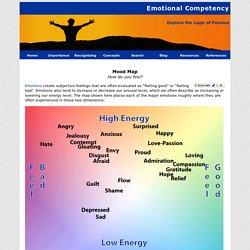
Emotions also tend to increase or decrease our arousal level, which we often describe as increasing or lowering our energy level. The map shown here places each of the major emotions roughly where they are often experienced in these two dimensions. The placement of each emotion on this map is only approximate and very subjective. Each emotion can vary greatly in intensity. For example anger can range from mild irritation to intense rage. Two other, more subtle dimensions also differentiate among emotions. These charts are based on the following data obtained from Averill, J.R. (1975) “A semantic atlas of emotional concepts”, JSAS Catalog of Selected Documents in Psychology, University of Massachusetts, Amherst, USA, Vol. 5, No. 330, pp.1-64 (Ms No. 1103).
The “activation” dimension is labeled High/Low energy and the “evaluation” dimension is labeled “Feel good/Feel bad” on the upper chart. What Colors Mean in Different Cultures. Colours in Cultures A Western / American B Japanese C Hindu D Native American E Chinese F Asian G Eastern European H Muslim I African J South American 1 Anger 2 Art / Creativity 3 Authority 4 Bad Luck 5 Balance 6 Beauty 7 Calm 8 Celebration 9 Children 10 Cold 11 Compassion 12 Courage 13 Cowardice 14 Cruelty 15 Danger 16 Death 17 Decadence 18 Deceit 19 Desire 20 Earthy 21 Energy 22 Erotic 23 Eternity 24 Evil 25 Excitement 26 Family 27 Femininity 28 Fertility 29 Flamboyance 30 Freedom 31 Friendly 32 Fun 33 God 34 Gods 35 Good Luck 36 Gratitude 37 Growth 38 Happiness 39 Healing 40 Healthy 41 Heat 42 Heaven Gray Yellow Silver Gold.
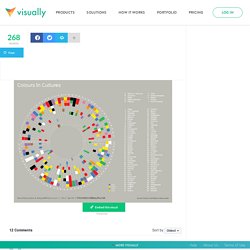
Emotional Intelligence on Pinterest. Faces of Product Pleasure: 25 Positive Emotions in Human-Product Interactions. Faces of Product Pleasure: 25 Positive Emotions in Human-Product Interactions Pieter M.
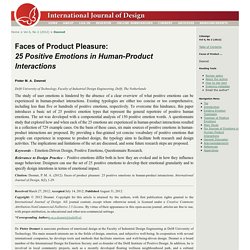
A. Desmet Delft University of Technology, Faculty of Industrial Design Engineering, Delft, The Netherlands. Human Emotions Chart - Free, Comprehensive Chart Of Emotions. List of Emotions - Human Emotional Chart. This list of human emotions plots the descending spiral of life from full vitality of the energy of life and high consciousness through half-vitality and half-consciousness down to death.
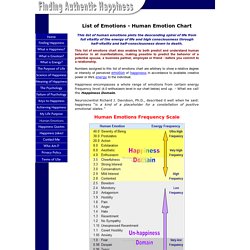
This list of emotions chart also enables to both predict and understand human behavior in all manifestations, making possible to predict the behavior of a potential spouse, a business partner, employee or friend - before you commit to a relationship. Numbers assigned to this list of emotions chart are arbitrary to show a relative degree or intensity of perceived emotion of happiness in accordance to available creative power or life's energy to the individual. Happiness encompasses a whole range of emotions from certain energy frequency level (4.0 enthusiasm level in our chart below) and up. - What we call the Happiness Domain. Neuroscientist Richard J. Davidson, Ph.D., described it well when he said: happiness “is a kind of a placeholder for a constellation of positive emotional states.
" The Abraham-Hicks Emotional Guidance Scale. Do2Learn: Educational Resources for Special Needs. Recognize these emotions. The Passion and Reason 15 The book Passion and Reason provides clear definitions and descriptions of 15 separate emotions.
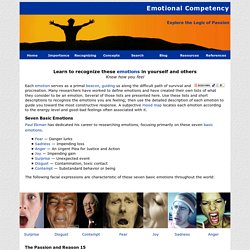
These are: Anger — Conspecific threat, trespass, loss attributed to an agent, unjust insult, thwarted goals, plea for justice Envy — Desiring other's stature objects Jealousy — Threat to sexual access. Fright — Concern for a future specific unpleasant event. Anxiety — Concern for an unidentified unpleasant event. The Rationalized 22. Test your social intelligence. Social Intelligence Test Test how well you can read emotions of others just by looking at their eyes.
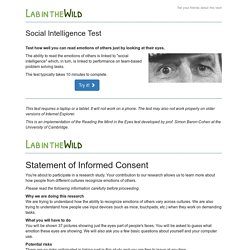
The ability to read the emotions of others is linked to "social intelligence" which, in turn, is linked to performance on team-based problem solving tasks. The test typically takes 10 minutes to complete. This test requires a laptop or a tablet. It will not work on a phone. This is an implementation of the Reading the Mind in the Eyes test developed by prof. You're about to participate in a research study. Please read the following information carefully before proceeding. Counseling - worksheets - printables on Pinterest. Emotion Regulation Handouts. Emotion Expression - Emotion Faces and Facial Analysis.
Neither emotion nor its expression are concepts universally embraced by psychologists.
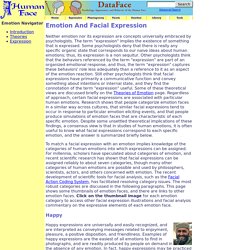
The term "expression" implies the existence of something that is expressed. Some psychologists deny that there is really any specific organic state that corresponds to our naive ideas about human emotions; thus, its expression is a non sequitur. Other psychologists think that the behaviors referenced by the term "expression" are part of an organized emotional response, and thus, the term "expression" captures these behaviors' role less adequately than a reference to it as an aspect of the emotion reaction.
Still other psychologists think that facial expressions have primarily a communicative function and convey something about intentions or internal state, and they find the connotation of the term "expression" useful. PsychSim_Shell. Psych Central - Trusted mental health, depression, bipolar, ADHD & psychology information. Cognitive Psychology and Cognitive Neuroscience/Motivation and Emotion. Introduction[edit] Happiness, sadness, anger, surprise, disgust and fear.
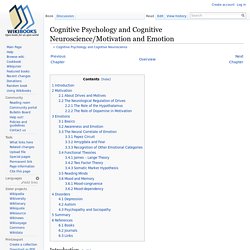
All these words describe some kind of abstract inner states in humans, in some cases difficult to control. We usually call them feelings or emotions. But what is the reason that we are able to "feel"? Intense Emotions and Strong Feelings. Theories of Emotions. OpenStax CNX - Content Library. Theories of Emotion. Emotions exert anincredibly powerful force on human behavior.

Strong emotions can cause you to take actions you might not normally perform, or avoid situations that you generally enjoy. Why exactly do we have emotions? What causes us to have these feelings? Emotion - The Psychology of Emotion. If you ask someone to describe what an emotion is, they might say it is a feeling, sentiment, reaction, passion, excitement, or sensation.
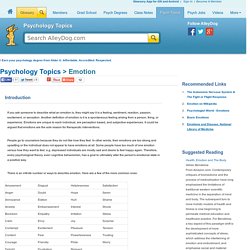
Another definition of emotion is it is a spontaneous feeling arising from a person, thing, or experience. Emotions are unique to each individual, are perception based, and subjective experiences. It could be argued that emotions are the sole reason for therapeutic interventions. People go to counselors because they do not like how they feel. Emotions - Psychology of Emotions. List of Feeling Words. Basic Emotions.